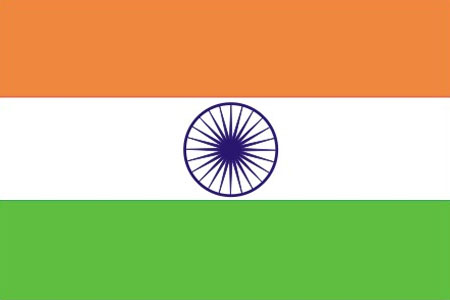On July 21st 1947, the National Flag was adopted by the Constituent Assembly.

During the 19th century, India was under British rule and a variety of flags were used by rulers of independent states in India, before the Indian independence movement began. It was after the Revolt of 1857 that the idea of a common Indian flag was proposed by the British. The first flag based on British symbols, also known as the Star of India was a group of flags used for different purposes by the British during their rule in India.
By the 20th century, around the time Edward VII was crowned king, it was decided that a symbol was required which represented the Indian Empire (as India was known then). It was around the same time that Indian nationalists thought that the flag required a religious symbol. Popular symbols at that time were that of Lord Ganesh, Goddess Kali or Gau Mata (the holy cow). These symbols were rejected on the grounds that they were Hindu centric, something to which Indian Muslims would find hard to relate.
The first Partition of Bengal in 1905 gave rise to a new Indian flag which aimed at uniting the people of India, irrespective of the caste, creed or religion they belonged to. This flag, known as the Vande Mataram flag, composed of Indian religious symbols, represented in a Western heraldic fashion. Launched during the Swadeshi movement against the British, this flag had eight white lotuses on the top white band (representing the eight provinces), a sun and a crescent on the bottom green band and the Bande Mataram slogan in the middle yellow band. This new flag was launched in Calcutta (now Kolkata) and barely received any coverage in the newspapers. The flag was used at the annual session of the Indian National Congress, though in the long run, it failed to gather nationalist sentiments among people.
Another proposal for the National Flag was suggested by Scottish Hindu reformist Sister Nivedita. This flag consisted of a thunderbold running through the middle and 108 oil lamps running along the border, with the Vande Mataram caption split across the border. This flag was also presented during the Indian National Congress meeting in 1906. This was followed by many other proposals for the national flag, but none attracted any attention from the nationalist movement. In 1916, Annie Besant and Bal Gangadhar Tilak recommended another national flag, which included the Union Jack at the top left hand corner, a star and crescent on the top right corner and seven stars diagonally from the lower right, placed against a backdrop of five red and four green alternating bands. This flag was banned by the Magistrate of Coimbatore, which was followed by a debate on the function and use of a national flag.
By the 1920s, it was Mahatma Gandhi’s desire to see all Indian communities represented on the flag of India, depicting a united country. A new flag was designed keeping these sentiments in mind. This flag comprised of a three colours: white on the top, green in the middle and red at the bottom. The colour white was to represent minority communities, green represented Muslims and red the Hindu and Sikh community. A charkha (spinning wheel) was drawn across all three colours symbolizing unity among all communities of India. Even though the Congress did not accept this flag, it was widely recognized as a symbol of patriotism and India’s struggle for freedom.
Not many people were happy with the communal representation with the flag proposed by Gandhi and, hence by 1931, another design was put forward for the national flag. This time the colour red had been replaced by ochre. This colour represented both Hindusim and Islam, since saffron was the colour of Hindu yogis as well as Muslim darvesh (dervish). But this led to the Sikh community demanding a separate colour for their religion as well, or a complete rejection of religious colours. This led to a new flag which was designed by Pingali Venkayya, an Indian freedom fighter. The new flag had three colours, saffron at the top, white in the middle and green at the bottom, with a charkha in between. The design of this flag was passed at a meeting of the Congress Committee in 1931 and was chosen as the official flag of the committee.
In 1947, when India gained freedom from the British, a committee headed by Dr. Rajendra Prasad decided to adopt the flag of the Congress as the national flag of India with a few modifications. With this in mind, the flag of 1931 was adopted as the national flag of India, but the charkha in the middle was replaced with the Ashoka Chakra. Thus, the Indian national flag was born. The saffron colour on top represents sacrifice, white represents truth, peace and purity and green signifies the law of dharma (righteousness).
Also On This Day:
1906: W.C. Bonnerjee, first President of Indian National Congress, passes away.
1977: Neelam Sanjiva Reddi is elected as President of India.
1988: Indian National Satellite (INSAT-1C) is launched.








